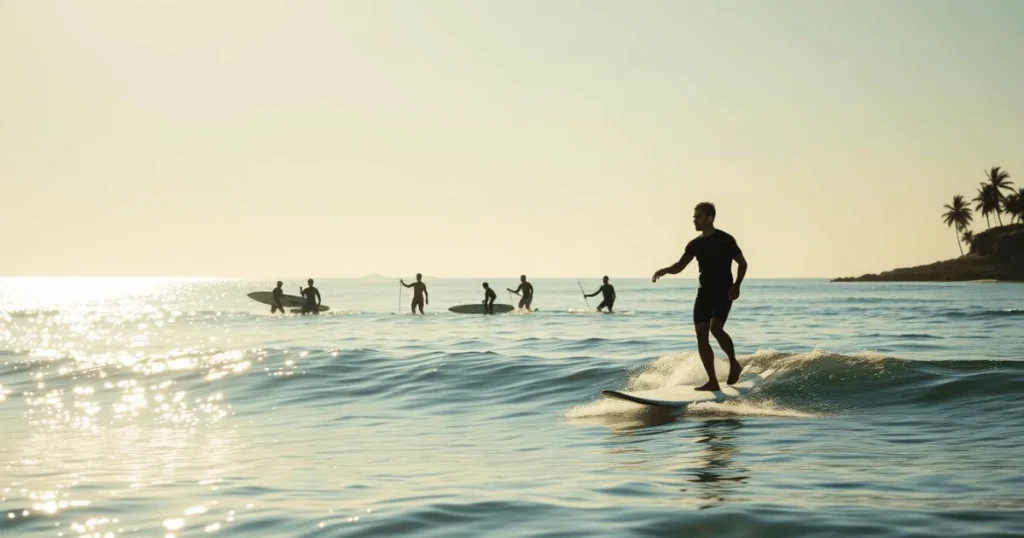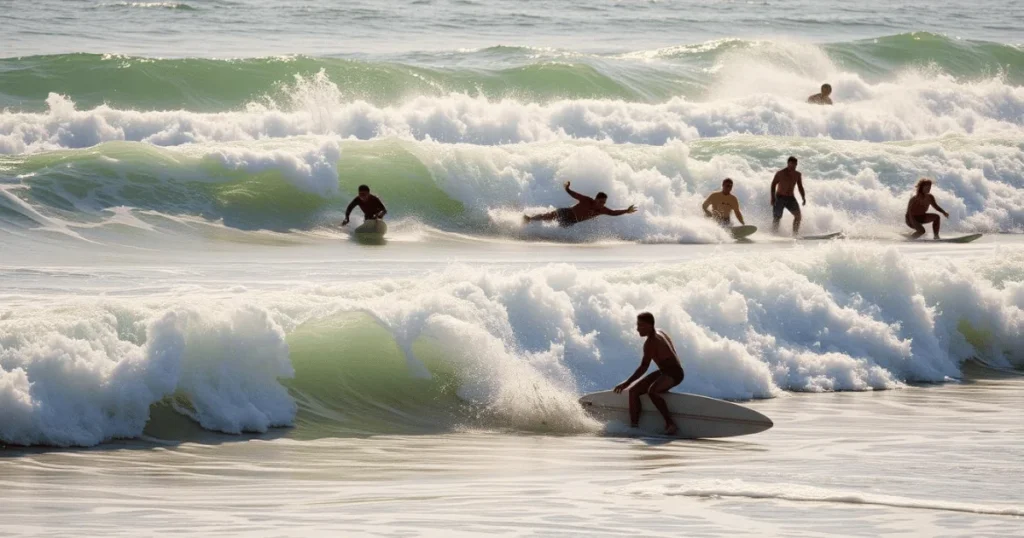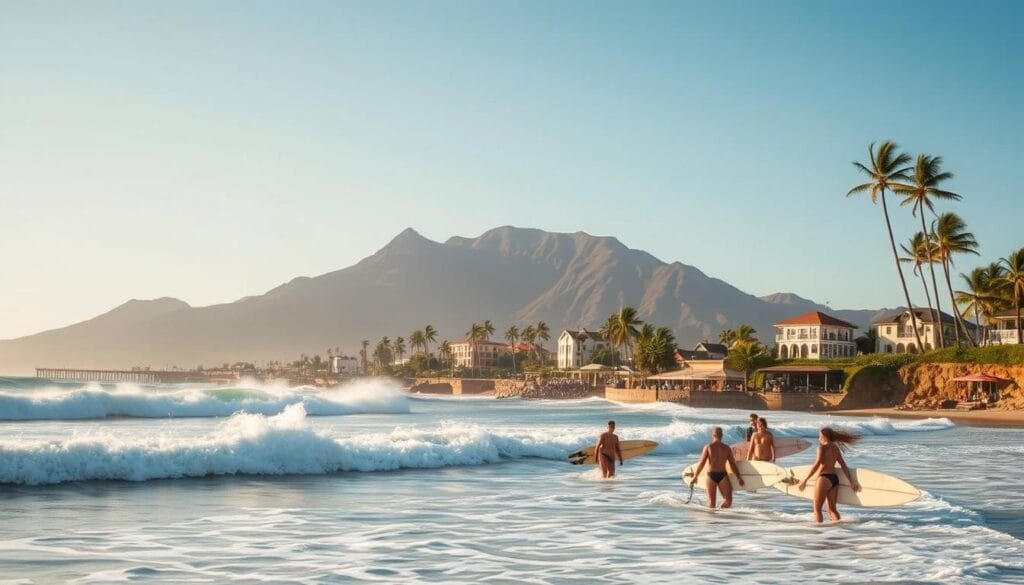How to Surf Like a Pro: Easy Tips for Beginners
Standing by the sea, breathing in the salty air, and listening to the crashing waves is an experience you won’t forget. Surfing is about more than just staying upright on a board. It opens doors to freedom, fitness, and nature. This guide will help you start your surfing journey, turning your first paddle into a memorable ride.
With simple steps and tips, you’ll grow more confident with each wave. You’ll learn to surf safely and enjoyably.

Table of Contents
Understanding the Basics of Surfing
Surfing for beginners is an adventure that mixes physical challenge with peaceful nature moments. It’s perfect for those who love fitness or want a new hobby. Learning to surf connects you deeply with the ocean.
What Makes Surfing Unique Among Water Sports
Surfing is different from swimming or kayaking because you balance on a board and read wave patterns. It’s like dancing with the ocean, learning its rhythm. This builds intuition and respect for nature.
The Physical and Mental Benefits of Surfing
- Full-body workout: Paddling strengthens arms, while standing improves core stability.
- Mindfulness in motion: Focusing on waves reduces stress, promoting mental clarity.
- Cardio boost: Constant movement elevates heart rate, enhancing endurance over time.
What to Expect When Learning to Surf
Learning to surf means falling, paddling, and laughing through wipeouts. At first, you might feel clumsy, but keep trying. Lessons teach safety, technique, and patience.
Expect sore muscles at first, but each successful ride boosts your confidence. Remember, wear a rash guard and sunscreen—sunburns can happen quickly, even on cloudy days!
Essential Surfing Gear for Beginners
Choosing the right surfing gear is key for a fun and safe start. Let’s look at what you need, starting with your surfboard.
Choosing Your First Surfboard
Beginners do best on surfboards that are stable and easy to use. The main types are foam boards, longboards, and mini-mals. Here’s how they compare:
| Type | Pros | Cons | Best For |
|---|---|---|---|
| Foam boards | Lightweight, buoyant | Less performance in strong waves | Beginners weighing under 150 lbs |
| Longboards | Great stability, easy paddling | Heavier to carry | Waves under 3-4 feet |
| Mini-mals | Compact design, responsive | Requires more skill | Intermediate learners |
Wetsuits and Surf Apparel
Wetsuits from brands like O’Neill or Rip Curl keep you warm in cold water. The thickness you need depends on how cold the water is. Wear a rash guard to avoid getting rubbed by the board.
Safety Equipment You Shouldn’t Skip
- Leash: Keeps your board with you in waves
- Surf wax: Gives the board’s tail grip
- Sunscreen: Use SPF 50+ for protection all day
Budget-Friendly Options for New Surfers
Rent gear first to see what you like. Used Firewire or Lost boards help save money. Make sure to invest in a good wetsuit and a durable leash.
Finding the Right Surf Spot for Beginners
Picking the right beach is essential for beginners learning to surf. Here are some surfing tips to help you find a safe and fun spot. Look for beaches with gentle waves that break softly. Sandy bottoms are safer than rocky ones, and areas with lifeguards offer extra safety.
- Check surf reports for “beginner” or “intermediate” ratings on apps like MagicSeaweed or Surfline.
- Ask local surf shops for recommendations—they know the best entry-level breaks in your area.
- Always avoid crowded spots; pick quieter beaches to practice without expert surfer traffic.
Before you paddle out, study the tide charts. Lower tides might uncover shallow reefs, while high tides can flatten waves. Wind direction is also important: onshore winds make waves easier to handle. Offshore winds create clean peaks but are harder for beginners.
Watch out for hidden dangers like rocks, kelp beds, or strong currents. If you’re unsure, consider a group lesson. Instructors can help find safe spots. Always check the conditions each day, as wave patterns can change frequently. Begin with the basics, keep an open mind, and always show respect to local surfers. Making smart choices now will help you build confidence for bigger waves later.
- Pro tip: Arrive early to catch morning glassy conditions before winds pick up.
- Use apps like Spotter to track wave heights—2–4 foot waves are ideal for starters.
Remember, the right spot is crucial for success. Focus on safety, research, and patience. Every pro started where you are now—so get out there!
How to Surf: Step-by-Step Techniques
Learning to surf involves breaking down each action into simple steps. Start by practicing these moves on land. Then, move to shallow water before tackling bigger waves. Consistency is key to building muscle memory.
Paddling Fundamentals
Good paddling gets you closer to the waves. How to surf begins with paddling:
- Extend arms fully, fingers together, to slice through water.
- Inhale deeply before each stroke to stabilize your core.
- Alternate arm pulls using a smooth, rhythmic motion.
Start by paddling in flat water to build endurance. Try to paddle 20 strokes in a row without stopping.
The Pop-Up: Transitioning from Lying to Standing
This move is all about speed. Here’s how to do it:
- Place hands under shoulders, knees tucking toward chest.
- Push upward with arms while thrusting legs behind into a low crouch.
- Land with feet parallel, toes angled forward.
Use yoga mats on land to get the hang of it. Do it 10 times a day.
Reading and Catching Your First Waves
Look for these signs to catch waves:
| Wave Clue | Action |
|---|---|
| Wave face tilting toward you | Paddle aggressively 3 seconds before it breaks |
| Flat wave surface | Wait for telltale ripples signaling energy buildup |
Start with waves that are 2-3 feet tall. They’re easier to handle at first.
Proper Stance and Balance
Stand with feet shoulder-width apart, front foot angled forward. Keep knees bent and hips low. This helps you stay in control. Use your core to adjust your weight as the board turns.
Practice balance by standing on a wobble board or foam roller on land.
Ocean Safety and Surf Etiquette
Learning surfing tips is more than just catching waves. It’s about staying safe and being respectful. First, learn to read the ocean’s signs. Look out for rip currents, which can be marked by choppy or discolored water. They can catch even the best surfers off guard.
If you get caught, don’t panic. Swim sideways to escape their grip. Always check beach warnings and stay out of the water during high-risk times.
Understanding Rip Currents and Ocean Hazards
Rip currents are narrow streams of water moving away from the shore. They can be spotted by looking for gaps in waves or dark, murky streaks. If you get caught:
- Stay calm and signal for help if needed.
- Swim alongside the shore to break free from the current.-
- Avoid fighting against the current’s force.
The Unwritten Rules of the Lineup
Respect others in the water—the surfer closest to the breaking wave has priority. If someone catches a wave, move out of their way by paddling.
Use hand signals to communicate. Point to show you’re targeting a wave. Never drop in—it’s key to avoid crashes and show respect.
Respecting Local Surf Communities
Every beach has its own culture. Do your research before visiting. Clean up any trash you find and don’t block access paths.
Support local shops and follow the rules. Locals appreciate visitors who respect the environment and traditions. This makes them welcome you back.
Common Mistakes New Surfers Make
Learning surfing for beginners is all about trying and learning from mistakes. Here are some common errors to avoid:
- Misplaced weight: Don’t lean too far back or forward. Keep your hips over the board’s rails.
- Poor wave timing: Paddling too early or late can mess up your catch. Start paddling when the wave begins to break.
- Incorrect pop-up: Don’t rush to stand up. Use a smooth 1-2-3 motion: crouch, then push up.
- Ignoring fitness: Weak muscles can make paddling hard. Include yoga or swimming in your routine.
- Wrong board choice—too small or too floaty can hold you back. Try different ones before buying.

Many beginners also make the mistake of choosing busy spots or expecting to get it right away. Start at places like Huntington Beach, CA, or Virginia Beach, VA, where the waves are easier. Remember, even pros fell 50 times their first session. Every wipeout is a chance to learn.
Keep track of your progress with a journal. Note what changes help you the most. Celebrate small victories, like standing for two seconds. Surfing for beginners is a journey of constant learning, not perfection.
Progressing Your Surfing Skills
Once you’ve learned to stand up and catch waves, it’s time to get better. These steps will help you move from basic skills to more advanced ones with confidence.
From Whitewater to Green Waves
Are you ready for unbroken waves? Look for swells that start smoothly. Wait until you can ride whitewater for 10+ waves without falling.
Learn to read wave faces to predict where they’ll break. Once confident, start with green waves in gentle conditions. Start near shore where waves are smaller but still rolling.
Basic Turning Techniques
- Bottom Turn: Carve sharply at the wave’s shoulder by leaning forward and shifting weight to the back foot.
- Cutback: Ride forward, then snap your hips to reconnect with the wave’s energy.
Drill these surfing techniques on manageable waves until they feel natural.
Building Paddle Strength
Strong paddling is key for a great session. Try 4×30-second paddling sprints in a pool or open water, resting 20 seconds between sets. Add core workouts like side planks and scissor kicks to keep your stance stable. Over time, you’ll paddle faster and stay longer on your riding waves.
The Best Surf Destinations for Beginners in the United States
Choosing the right place to start surfing is key. The U.S. has three top spots for beginners. These places offer gentle waves, perfect conditions, and great surf lessons. Let’s find the best spot for your first wave.

West Coast Beginner Spots
California’s coast is perfect for new surfers:
- Santa Cruz: Waves are steady at 2–4ft. Santa Cruz Surf School offers 2-hour group lessons at $70.
- Huntington Beach: It has action all year. HB Surf School offers sessions for $85.
- Depoe Bay, Oregon: It has sheltered coves. Depoe Surf Co. teaches for $65.
East Coast Learning Breaks
The East Coast offers mellow waves and warm, friendly waters:
- Wrightsville Beach, NC: It has protected breaks. Carolina Surf School offers $90 beginner packages.
- Folly Beach, SC: Waves are shallow and forgiving. Lessons start at $80.
- Myrtle Beach, SC: It has consistent surf. Rentals and Myrtle Waves School offer lessons for $75/hour.
Hawaii’s Beginner-Friendly Beaches
Hawaii has legendary waves with beginner zones:
- Waikiki Beach, Oahu: It has sandy shores and Pipeline Lessons for $95. Sessions last 2 hours.
- Ka’anapali, Maui: It has gentle rollers. Classes from Maui Surf School cost $85.
| Location | Wave Type | Surf Lessons | Season |
|---|---|---|---|
| Santa Cruz | Mellow beach breaks | 70–95$ | June–Oct |
| Wrightsville Beach | Sheltered tidal waves | 80–90$ | May–Sept |
| Waikiki | Beginner-friendly shorebreak | 95$ | Year-round |
Each spot offers surf lessons, rentals, and lodging nearby. Check conditions and book early to secure your spot.
Joining the Surf Culture
Surf culture is more than just riding waves. It’s a lively way of life that started in ancient Polynesia and now thrives in coastal areas. It blends excitement with a strong reverence for the ocean. Beginners can start by visiting local surf shops, attending community events, and exploring online forums.
Embracing surf culture means learning its unique language. Terms like “hang ten” and “kook” are not just words—they’re part of a shared identity. Fashion also plays a big role, with brands like Billabong and Patagonia offering both style and function. Many surfers also support environmental causes, like beach cleanups and organizations like Surfrider Foundation.
- Media to Explore: Watch documentaries like Riding Giants or listen to podcasts such as Surfline’s WaveCast.
- Join local surf festivals such as the O’Neill Cold Water Classic to connect with other surf enthusiasts.
- Follow surf artists or photographers on social media to see how creativity connects to the ocean.
Becoming part of surf culture is about blending tradition with your own unique style. Whether through music, art, or activism, there’s a place for everyone. Remember: respect the ocean, learn from others, and stay curious. The culture grows when newcomers bring their own perspectives to the lineup.
Conclusion: Riding the Wave of Your Surfing Journey
Starting your surfing journey is all about taking small steps. Every time you paddle out, you’re getting stronger and more focused. You’re also getting closer to the ocean.
Begin by practicing the techniques you’ve learned. Whether it’s mastering the pop-up or reading waves, each session helps you improve.
Surfing goes beyond sport—it links you to the ocean and a shared culture. Join local surf clubs or classes to learn from others. You’ll find lessons at places like Oahu’s Waikiki Beach or California’s Trestles.
Start with simple gear like a foam board or a basic wetsuit. Always wear safety gear, such as a leash and rash guard.
Don’t be afraid of challenges like wobbly starts and missed waves. They’re part of the learning process. Set goals, like surfing three times a month, and track your progress.
The ocean teaches patience, so enjoy each wave. With time, those early paddles will turn into smooth, confident maneuvers. The best part? The thrill of catching a wave and the friends you make along the way. The water is waiting for you—go ride it.
